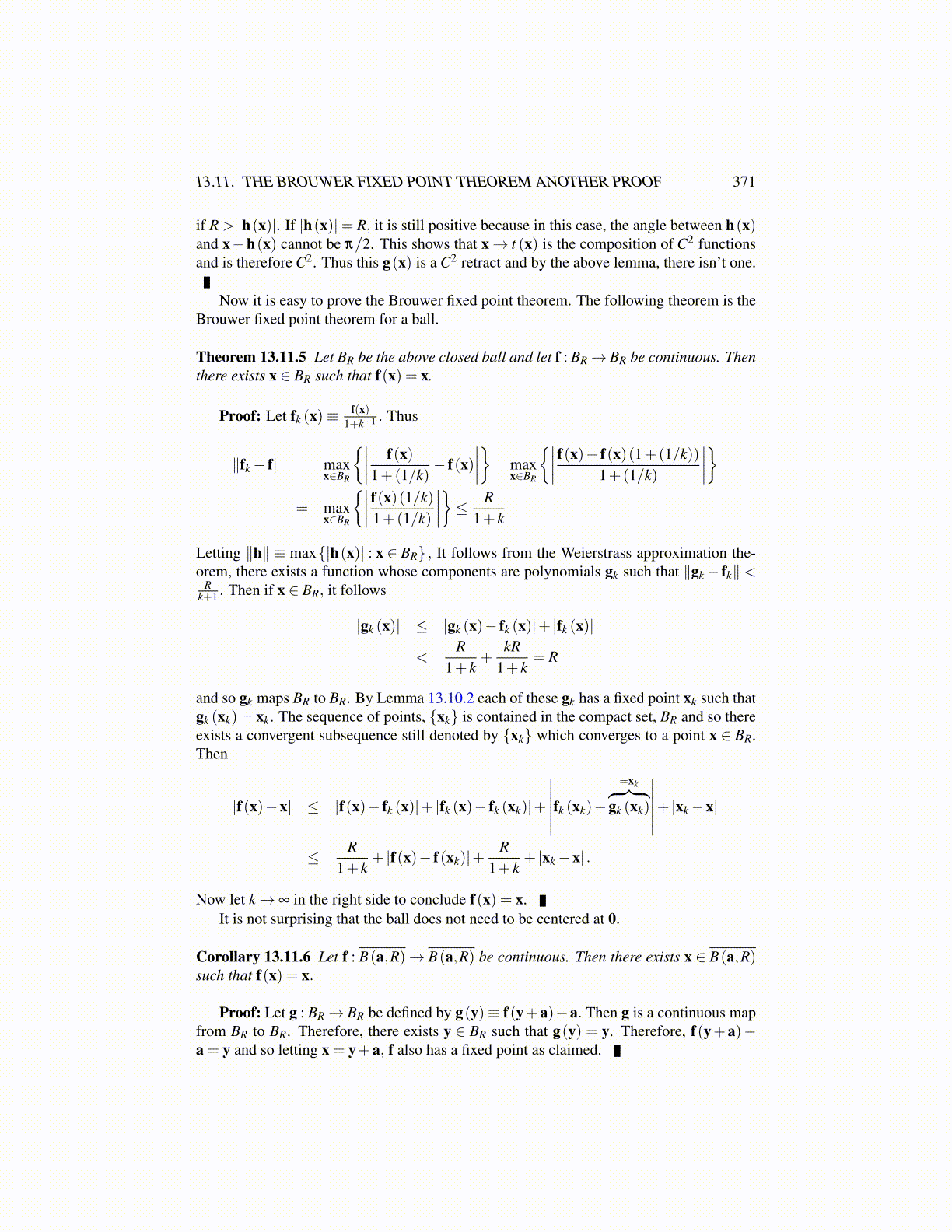
13.11. THE BROUWER FIXED POINT THEOREM ANOTHER PROOF 371
if R > |h(x)|. If |h(x)|= R, it is still positive because in this case, the angle between h(x)and x−h(x) cannot be π/2. This shows that x→ t (x) is the composition of C2 functionsand is therefore C2. Thus this g(x) is a C2 retract and by the above lemma, there isn’t one.
Now it is easy to prove the Brouwer fixed point theorem. The following theorem is theBrouwer fixed point theorem for a ball.
Theorem 13.11.5 Let BR be the above closed ball and let f : BR→ BR be continuous. Thenthere exists x ∈ BR such that f(x) = x.
Proof: Let fk (x)≡ f(x)1+k−1 . Thus
∥fk− f∥ = maxx∈BR
{∣∣∣∣ f(x)1+(1/k)
− f(x)∣∣∣∣}= max
x∈BR
{∣∣∣∣ f(x)− f(x)(1+(1/k))1+(1/k)
∣∣∣∣}= max
x∈BR
{∣∣∣∣ f(x)(1/k)1+(1/k)
∣∣∣∣}≤ R1+ k
Letting ∥h∥ ≡ max{|h(x)| : x ∈ BR} , It follows from the Weierstrass approximation the-orem, there exists a function whose components are polynomials gk such that ∥gk− fk∥ <
Rk+1 . Then if x ∈ BR, it follows
|gk (x)| ≤ |gk (x)− fk (x)|+ |fk (x)|
<R
1+ k+
kR1+ k
= R
and so gk maps BR to BR. By Lemma 13.10.2 each of these gk has a fixed point xk such thatgk (xk) = xk. The sequence of points, {xk} is contained in the compact set, BR and so thereexists a convergent subsequence still denoted by {xk} which converges to a point x ∈ BR.Then
|f(x)−x| ≤ |f(x)− fk (x)|+ |fk (x)− fk (xk)|+
∣∣∣∣∣∣fk (xk)−
=xk︷ ︸︸ ︷gk (xk)
∣∣∣∣∣∣+ |xk−x|
≤ R1+ k
+ |f(x)− f(xk)|+R
1+ k+ |xk−x| .
Now let k→ ∞ in the right side to conclude f(x) = x.It is not surprising that the ball does not need to be centered at 0.
Corollary 13.11.6 Let f : B(a,R)→ B(a,R) be continuous. Then there exists x ∈ B(a,R)such that f(x) = x.
Proof: Let g : BR→ BR be defined by g(y)≡ f(y+a)−a. Then g is a continuous mapfrom BR to BR. Therefore, there exists y ∈ BR such that g(y) = y. Therefore, f(y+a)−a = y and so letting x = y+a, f also has a fixed point as claimed.